A Receding Horizon Navigation and Control System for Autonomous Merchant Ships: Reducing Fuel Costs and Carbon Emissions under the Premise of Safety
Abstract
1. Introduction
- The design of a new autonomous navigation system is proposed, which accomplishes the economic and green goals of navigation in the path planning module and ensures the safety of navigation in the control module;
- Based on the superposition of fields, cost and emission fields according to their consumption rate are constructed, and guided fields are designed to transform the path search problem into a gradient descent optimization problem to solve the multi-objective path planning problem of MASS;
- A navigation and control system framework for path planning and rolling NMPC tracking control co-optimization is designed for the problem of determining whether the reference trajectory and tracking controller track with high accuracy during multi-objective planning.
2. Problem Statement
2.1. Problem Description
- (i)
- A guidance module for multi-objective path planning;
- (ii)
- A control module for precise trajectory tracking and to guarantee navigation safety;
- (iii)
- The collaborative optimization of guidance and control for information interaction and synergy optimization between navigation and control modules.
2.2. Framework of Receding Horizon Navigation and Control System
3. Guidance Module
3.1. Fields Based on Cost and Emission
3.2. Guidance Field
3.3. Field Renewable Local Path Planning Algorithm
3.3.1. Superposition of Fields
3.3.2. Event Trigger Mechanism
3.3.3. Path Planning Based on Superposition Field
- Calculate guide field Gk and initial superposition field according to Equations (1)–(6).
- Judge whether the vessel is in the collision avoidance state. If the distance between the vessel and the obstacle is greater than or equal to danger range , the vessel is judged to be in the regular navigation state; if the distance between the vessel and the obstacle is less than danger range , the vessel is judged to be in the regular collision avoidance state. In that case, when the coordinates of the vessel on both the X and Y axes exceed the obstacle or other vessel, the vessel is transferred from the collision avoidance to regular navigation state.
- If the ship is in the state of collision avoidance, calculate gradient ▽(p(k)) from ; if in the state of regular navigation, calculate the gradient from .
- Obtain path points p(k + ) = p(k) − (k) ∗ ▽(p(k)).
| Algorithm 1 Local path planning. |
| Input: Gradient of field |
| Output: Trajectory of MASS p(x) |
|
4. NMPC-Based Trajectory Tracking Control and Collision Avoidance
4.1. Maritime Autonomous Surface Ship System Modeling
4.2. Trajectory Tracking Control
- The optimization problem (23) is solved with the current state error as the initial state and , (k = 0, 1, 2,…, N − 1) as a set of optimal solutions to the control problem.
- The system only uses the first optimal solution as the control output for one sampling period , as a control decision for the MASS.
- At moment at the beginning of the next sampling period, the optimization problem (23) is solved again using the latest measurement data .
5. Collaborative Optimization of Path Planning and Tracking Control
5.1. Interface I for Path Planning
5.2. Process of the Closed-Loop Structure
| Algorithm 2 Path planning and trajectory tracking control. |
| Input: Field and reference trajectory |
| Output: Optimum control and real trajectory |
|
6. Simulation
6.1. Experimental Design
6.1.1. Marine Environment
6.1.2. Experimental Parameters
6.1.3. Experimental Design
6.2. Simulation Results
6.2.1. Contrast Experiments Considering Carbon Emissions and No Carbon Emissions in Local Path Planning
6.2.2. Simulation Experiments of Receding Horizon Navigation and Control System in Global Planning
6.2.3. Simulation Experiments of Real-Time Path Planning and Tracking Control with Collision Avoidance
Scenario: Static Collision Avoidance
Scenario: Head-on
6.2.4. RHNC System with Collision Avoidance and Event Triggering
7. Conclusions
Author Contributions
Funding
Institutional Review Board Statement
Informed Consent Statement
Conflicts of Interest
References
- Fossen, T.I. Marine Control Systems–Guidance. Navigation, and Control of Ships, Rigs and Underwater Vehicles. Marine Cybernetics, Trondheim, Norway, Org. Number NO 985 195 005 MVA, 2002. ISBN: 8292356002. Available online: www.marinecybernetics.com (accessed on 15 December 2022).
- Chen, Y.; Bai, G.; Zhan, Y.; Hu, X.; Liu, J. Path planning and obstacle avoiding of the USV based on improved ACO-APF hybrid algorithm with adaptive early-warning. IEEE Access 2021, 9, 40728–40742. [Google Scholar] [CrossRef]
- Chen, Z.; Zhang, Y.; Zhang, Y.; Nie, Y.; Tang, J.; Zhu, S. A hybrid path planning algorithm for unmanned surface vehicles in complex environment with dynamic obstacles. IEEE Access 2019, 7, 126439–126449. [Google Scholar] [CrossRef]
- Sen, D.; Padhy, C.P. An approach for development of a ship routing algorithm for application in the North Indian Ocean region. Appl. Ocean Res. 2015, 50, 173–191. [Google Scholar] [CrossRef]
- Mannarini, G.; Coppini, G.; Oddo, P.; Pinardi, N. A prototype of ship routing decision support system for an operational oceanographic service. TransNav: Int. J. Mar. Navig. Saf. Sea Transp. 2013, 7, 53–59. [Google Scholar] [CrossRef]
- Jung, J.; Rhyu, K. A study on the optimal navigation route decision using A* algorithm. J. Korea Soc. Comput. Inf. 1999, 4, 38–46. [Google Scholar]
- Szlapczynska, J. Multi-objective weather routing with customised criteria and constraints. J. Navig. 2015, 68, 338–354. [Google Scholar] [CrossRef]
- Singh, Y.; Sharma, S.; Sutton, R.; Hatton, D.; Khan, A. A constrained A* approach towards optimal path planning for an unmanned surface vehicle in a maritime environment containing dynamic obstacles and ocean currents. Ocean Eng. 2018, 169, 187–201. [Google Scholar] [CrossRef]
- Xie, L.; Xue, S.; Zhang, J.; Zhang, M.; Tian, W.; Haugen, S. A path planning approach based on multi-direction A* algorithm for ships navigating within wind farm waters. Ocean Eng. 2019, 184, 311–322. [Google Scholar] [CrossRef]
- Yu, K.; Liang, X.F.; Li, M.Z.; Chen, Z.; Yao, Y.L.; Li, X.; Zhao, Z.X.; Teng, Y. USV path planning method with velocity variation and global optimisation based on AIS service platform. Ocean Eng. 2021, 236, 109560. [Google Scholar] [CrossRef]
- Liu, X.; Li, Y.; Zhang, J.; Zheng, J.; Yang, C. Self-adaptive dynamic obstacle avoidance and path planning for USV under complex maritime environment. IEEE Access 2019, 7, 114945–114954. [Google Scholar] [CrossRef]
- Wang, X.; Zhao, X.; Wang, G.; Wang, Q.; Feng, K. Weather Route Optimization Method of Unmanned Ship Based on Continuous Dynamic Optimal Control. Sustainability 2022, 14, 2165. [Google Scholar] [CrossRef]
- Fox, D.; Burgard, W.; Thrun, S. The dynamic window approach to collision avoidance. IEEE Robot. Autom. Mag. 1997, 4, 23–33. [Google Scholar] [CrossRef]
- Kuwata, Y.; Wolf, M.T.; Zarzhitsky, D.; Huntsberger, T.L. Safe maritime autonomous navigation with COLREGS, using velocity obstacles. IEEE J. Ocean Eng. 2013, 39, 110–119. [Google Scholar] [CrossRef]
- Wu, P.; Xie, S.; Liu, H.; Li, M.; Li, H.; Peng, Y.; Li, X.; Luo, J. Autonomous obstacle avoidance of an unmanned surface vehicle based on cooperative manoeuvring. Ind. Robot. Int. J. 2017, 44, 64–74. [Google Scholar] [CrossRef]
- Azzabi, A.; Nouri, K. An advanced potential field method proposed for mobile robot path planning. Trans. Inst. Meas. Control. 2019, 41, 3132–3144. [Google Scholar] [CrossRef]
- Sang, H.; You, Y.; Sun, X.; Zhou, Y.; Liu, F. The hybrid path planning algorithm based on improved A* and artificial potential field for unmanned surface vehicle formations. Ocean Eng. 2021, 223, 108709. [Google Scholar] [CrossRef]
- Liu, Y.; Bucknall, R. Path planning algorithm for unmanned surface vehicle formations in a practical maritime environment. Ocean Eng. 2015, 97, 126–144. [Google Scholar] [CrossRef]
- Li, D.; Du, L. Auv trajectory tracking models and control strategies: A review. J. Mar. Sci. Eng. 2021, 9, 1020. [Google Scholar] [CrossRef]
- Truong, T.N.; Vo, A.T.; Kang, H.J. A backstepping global fast terminal sliding mode control for trajectory tracking control of industrial robotic manipulators. IEEE Access 2021, 9, 31921–31931. [Google Scholar] [CrossRef]
- Liu, S.Q.; Sang, Y.J.; Whidborne, J.F. Adaptive sliding-mode-backstepping trajectory tracking control of underactuated airships. Aerosp. Sci. Technol. 2020, 97, 105610. [Google Scholar] [CrossRef]
- Liu, L.; Wang, D.; Peng, Z.; Han, Q.L. Distributed path following of multiple under-actuated autonomous surface vehicles based on data-driven neural predictors via integral concurrent learning. IEEE Trans. Neural Networks Learn. Syst. 2021, 32, 5334–5344. [Google Scholar] [CrossRef]
- Li, J.; Du, J.; Chen, C.P. Command-filtered robust adaptive NN control with the prescribed performance for the 3-D trajectory tracking of underactuated AUVs. IEEE Trans. Neural Networks Learn. Syst. 2021, 33, 6545–6557. [Google Scholar] [CrossRef] [PubMed]
- Li, H.; Yan, W. Model predictive stabilization of constrained underactuated autonomous underwater vehicles with guaranteed feasibility and stability. IEEE/Asme Trans. Mechatron. 2016, 22, 1185–1194. [Google Scholar] [CrossRef]
- Li, H.; Shi, Y. Distributed receding horizon control of large-scale nonlinear systems: Handling communication delays and disturbances. Automatica 2014, 50, 1264–1271. [Google Scholar] [CrossRef]
- Yang, K.; Tang, X.; Qin, Y.; Huang, Y.; Wang, H.; Pu, H. Comparative study of trajectory tracking control for automated vehicles via model predictive control and robust H-infinity state feedback control. Chin. J. Mech. Eng. 2021, 34, 74. [Google Scholar] [CrossRef]
- Abdelaal, M.; Fränzle, M.; Hahn, A. Nonlinear Model Predictive Control for trajectory tracking and collision avoidance of underactuated vessels with disturbances. Ocean Eng. 2018, 160, 168–180. [Google Scholar] [CrossRef]
- Zhao, B.; Zhang, X.; Liang, C.; Han, X. An Improved Model Predictive Control for Path-Following of USV Based on Global Course Constraint and Event-Triggered Mechanism. IEEE Access 2021, 9, 79725–79734. [Google Scholar] [CrossRef]
- Zheng, J.; Hu, J.; Li, Y. Codesign of dynamic collision avoidance and trajectory tracking for autonomous surface vessels with nonlinear model predictive control. Proc. Inst. Mech. Eng. Part M J. Eng. Marit. Environ. 2022, 236, 938–952. [Google Scholar] [CrossRef]
- Ji, J.; Khajepour, A.; Melek, W.W.; Huang, Y. Path planning and tracking for vehicle collision avoidance based on model predictive control with multiconstraints. IEEE Trans. Veh. Technol. 2016, 66, 952–964. [Google Scholar] [CrossRef]
- Wang, B.; Zhang, Y.; Zhang, W. Integrated path planning and trajectory tracking control for quadrotor UAVs with obstacle avoidance in the presence of environmental and systematic uncertainties: Theory and experiment. Aerosp. Sci. Technol. 2022, 120, 107277. [Google Scholar] [CrossRef]
- Shen, C.; Shi, Y.; Buckham, B. Integrated path planning and tracking control of an AUV: A unified receding horizon optimization approach. IEEE/ASME Trans. Mechatron. 2016, 22, 1163–1173. [Google Scholar] [CrossRef]
- Roh, M.I. Determination of an economical shipping route considering the effects of sea state for lower fuel consumption. Int. J. Nav. Archit. Ocean Eng. 2013, 5, 246–262. [Google Scholar] [CrossRef]
- Zaccone, R.; Ottaviani, E.; Figari, M.; Altosole, M. Ship voyage optimization for safe and energy-efficient navigation: A dynamic programming approach. Ocean Eng. 2018, 153, 215–224. [Google Scholar] [CrossRef]
- Polvara, R.; Sharma, S.; Wan, J.; Manning, A.; Sutton, R. Obstacle avoidance approaches for autonomous navigation of unmanned surface vehicles. J. Navig. 2018, 71, 241–256. [Google Scholar] [CrossRef]
- Li, Y.; Zheng, J. Real-time collision avoidance planning for unmanned surface vessels based on field theory. ISA Trans. 2020, 106, 233–242. [Google Scholar] [CrossRef]
- Hollenbach, U.; Friesch, J. Efficient hull forms—What can be gained. In Proceedings of the 1st International Conference on Ship Efficiency, Hamburg, Germany, 8–9 October 2007. [Google Scholar]
- Prpić-Oršić, J.; Faltinsen, O.M. Estimation of ship speed loss and associated CO2 emissions in a seaway. Ocean Eng. 2012, 44, 1–10. [Google Scholar] [CrossRef]
- Fossen, T.I. Handbook of Marine Craft Hydrodynamics and Motion Control; John Wiley & Sons: Hoboken, NJ, USA, 2011. [Google Scholar]
- Zis, T.P.; Psaraftis, H.N.; Ding, L. Ship weather routing: A taxonomy and survey. Ocean Eng. 2020, 213, 107697. [Google Scholar] [CrossRef]
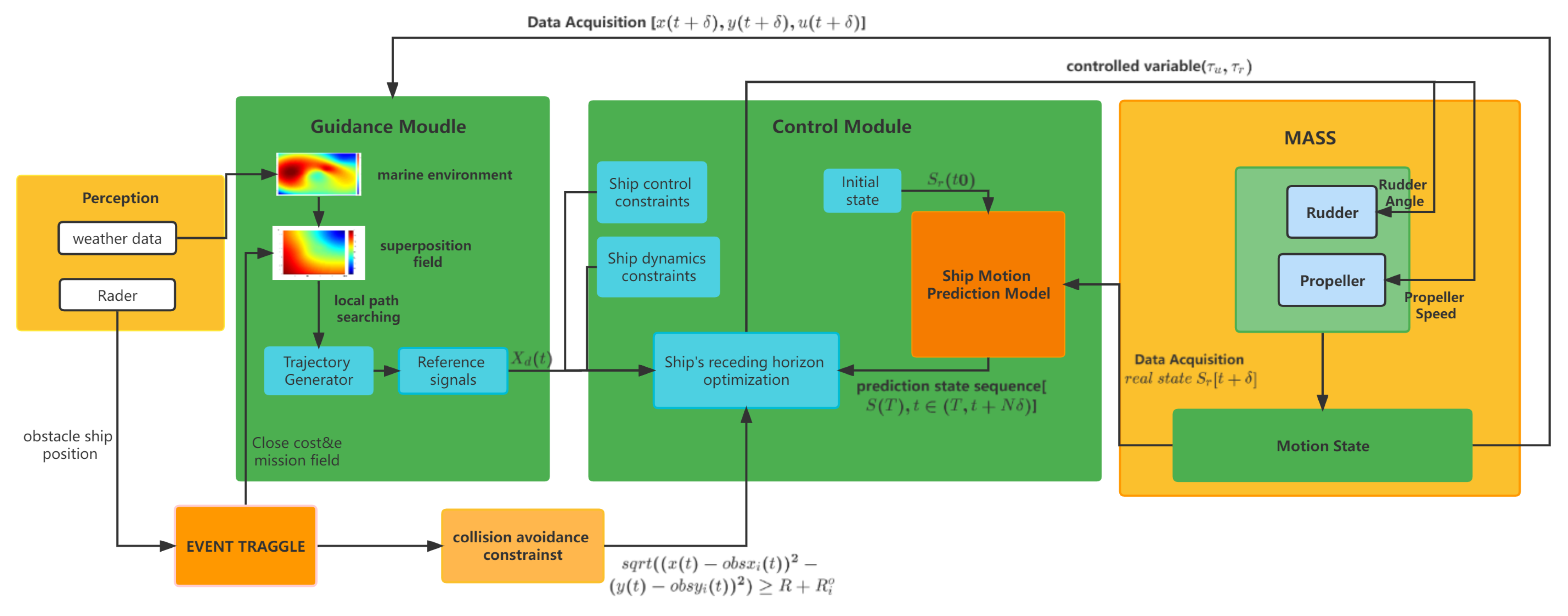


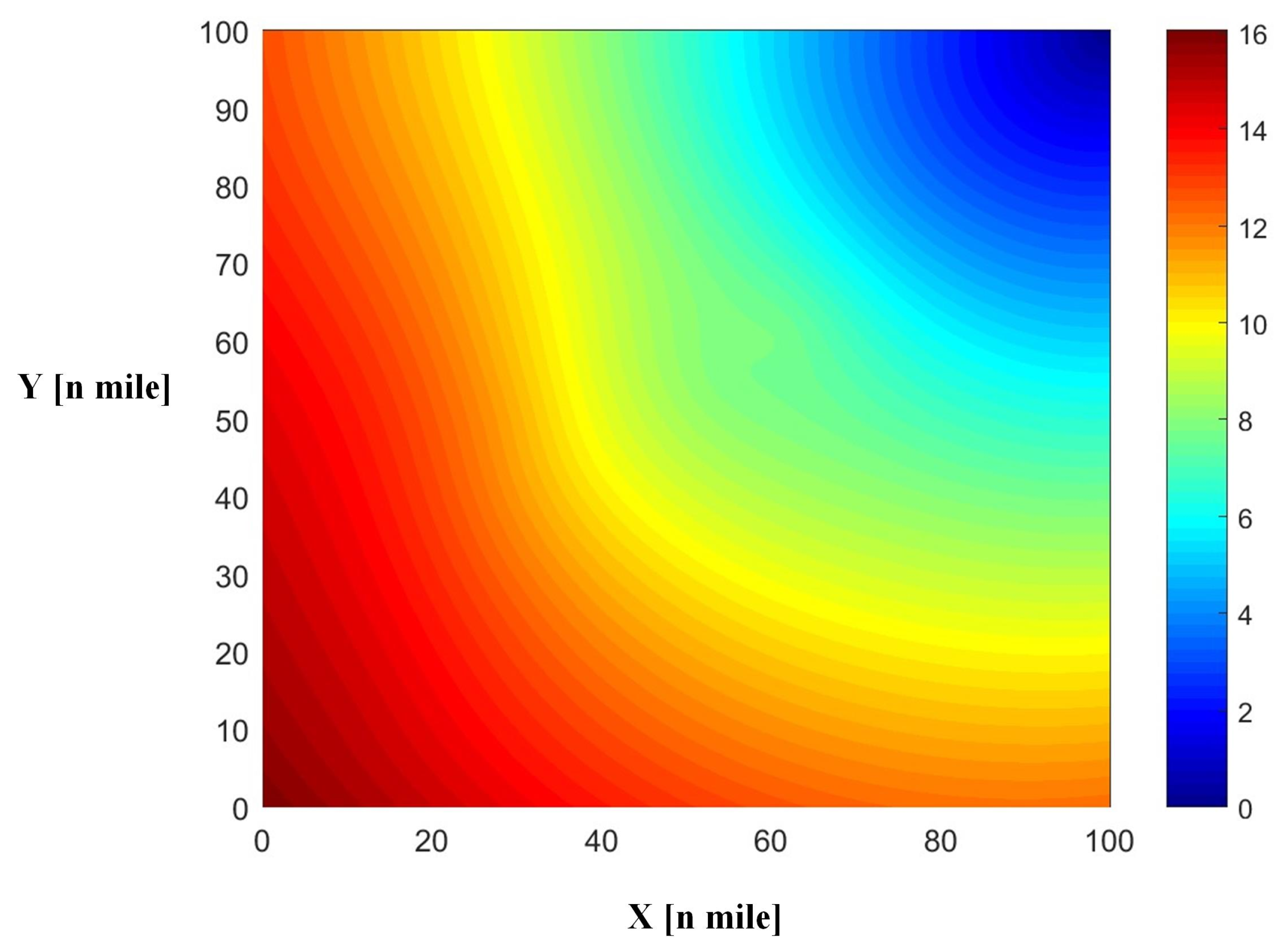
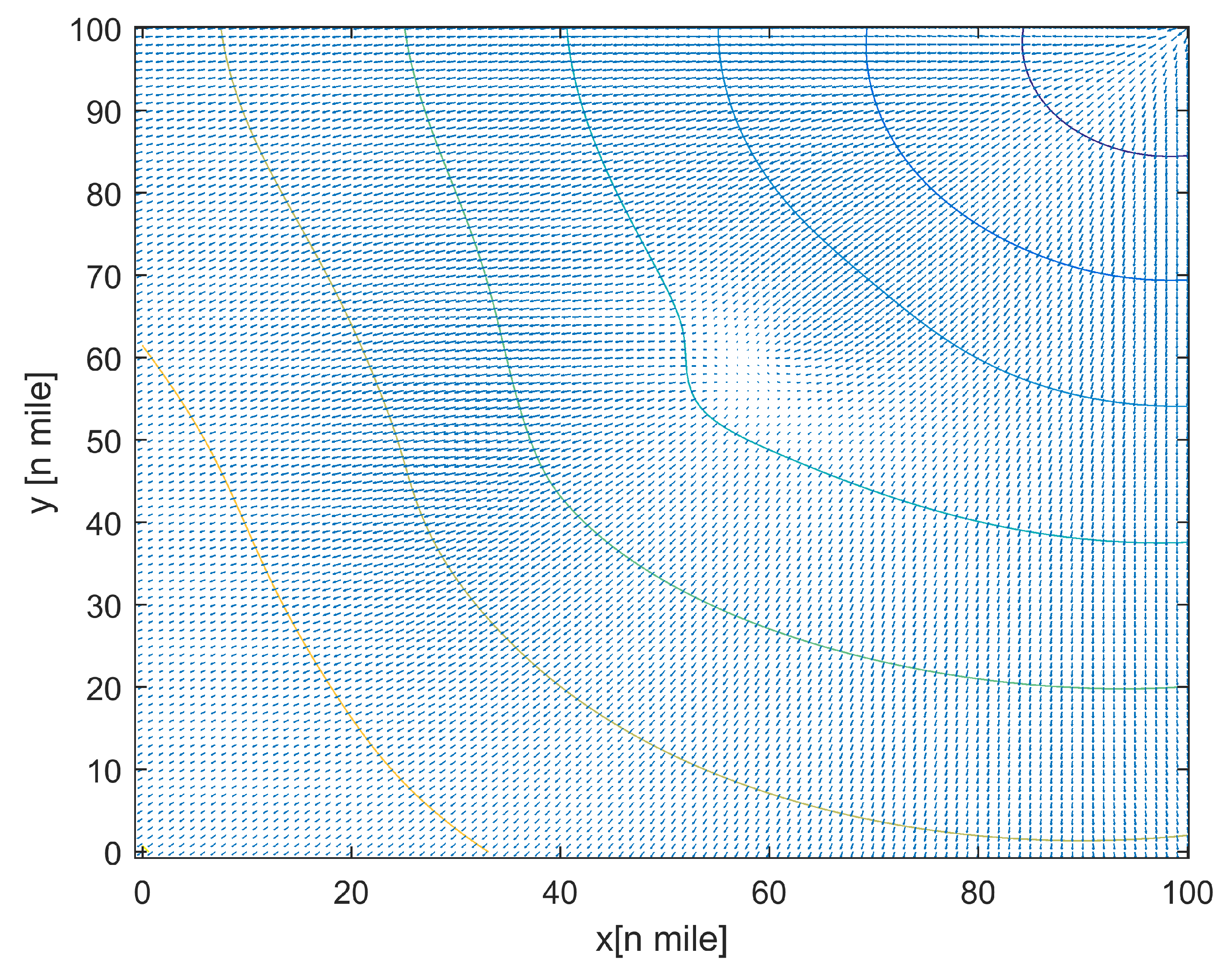
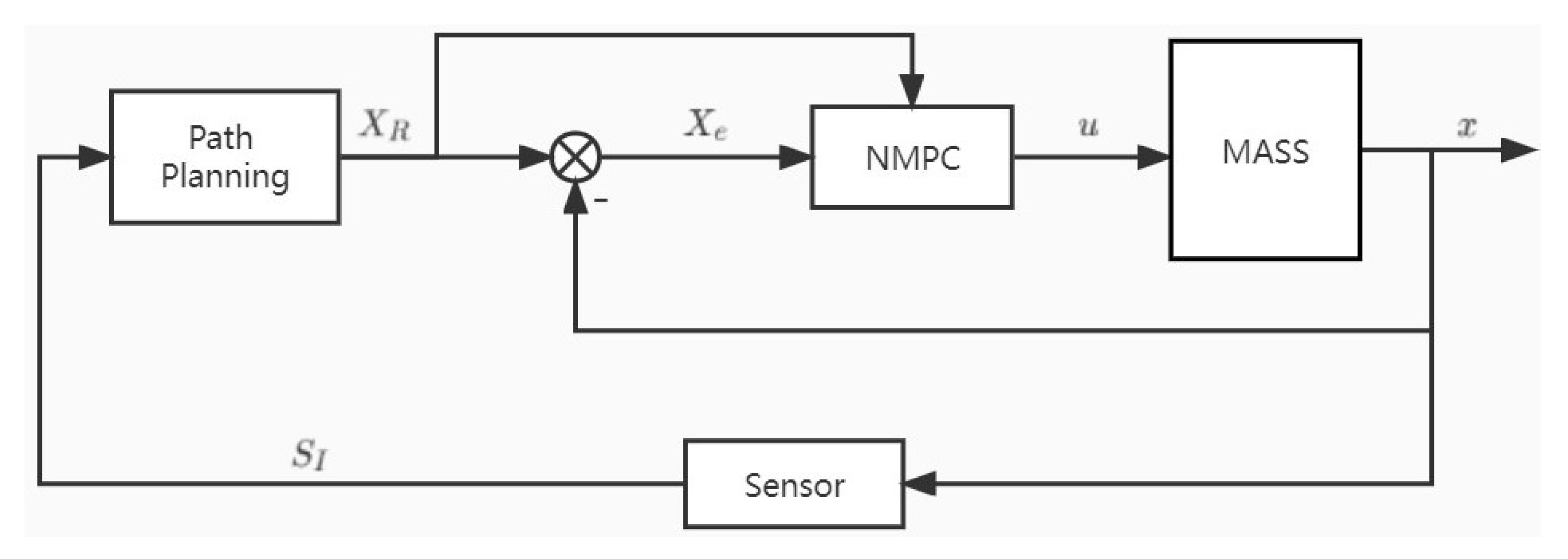

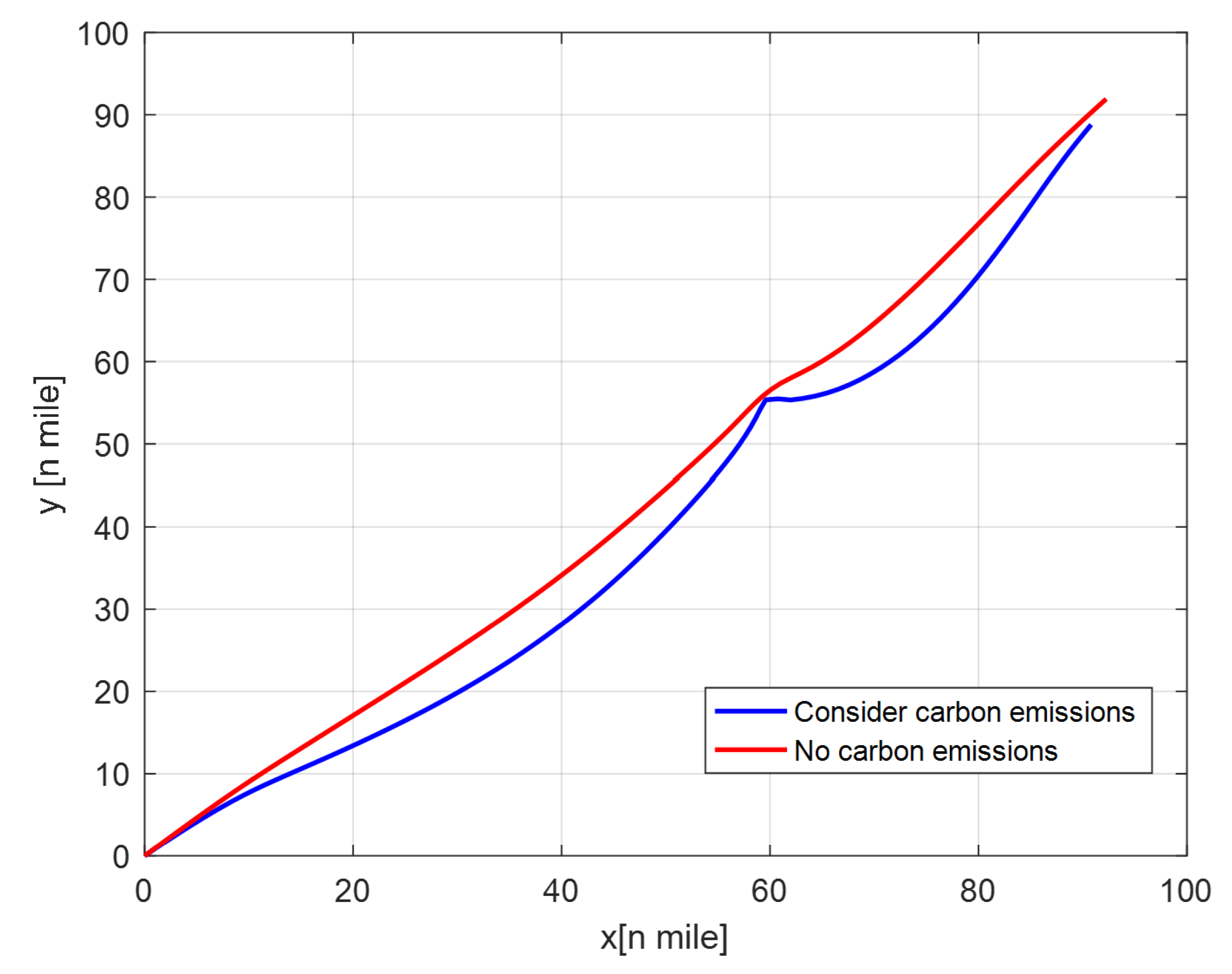
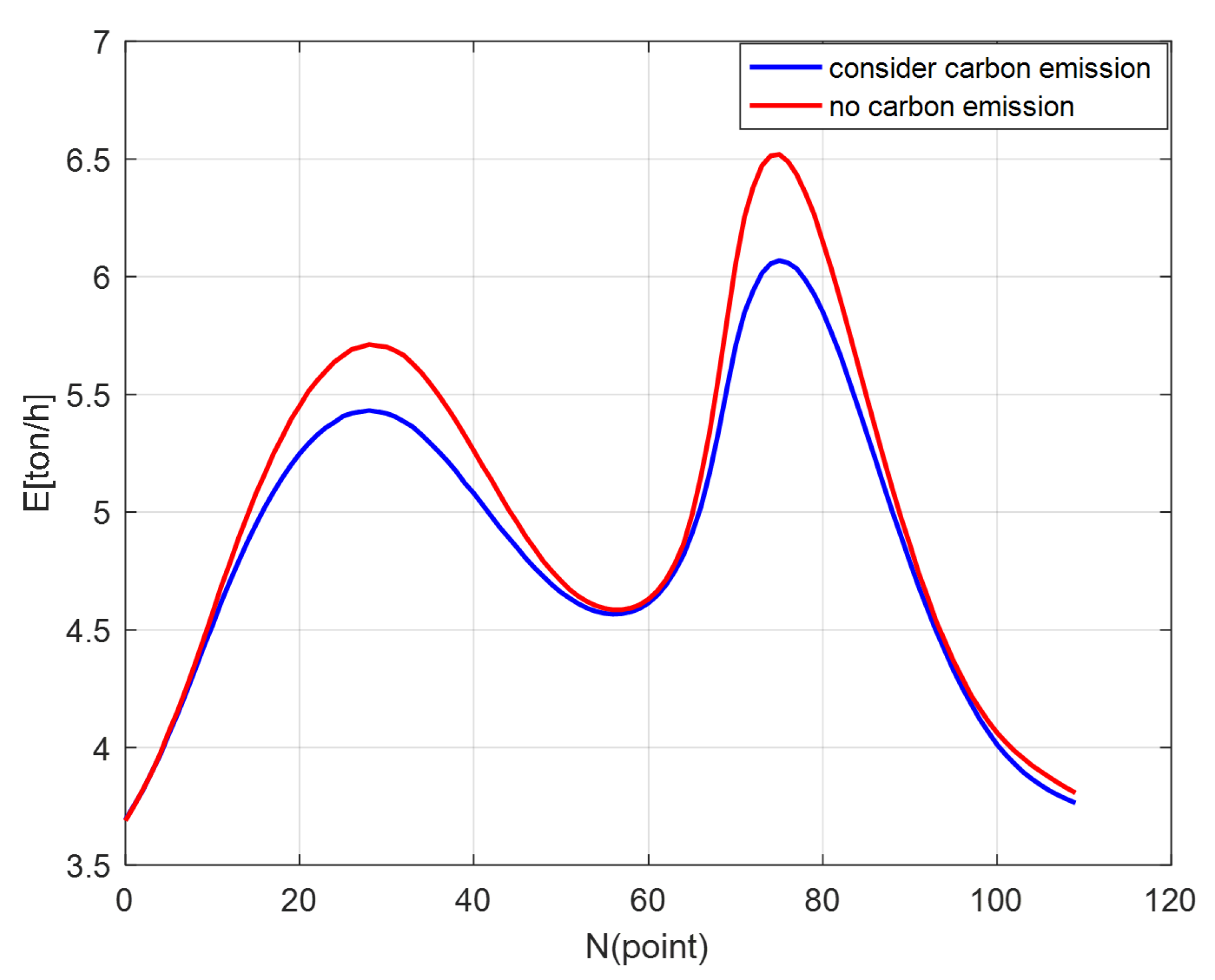

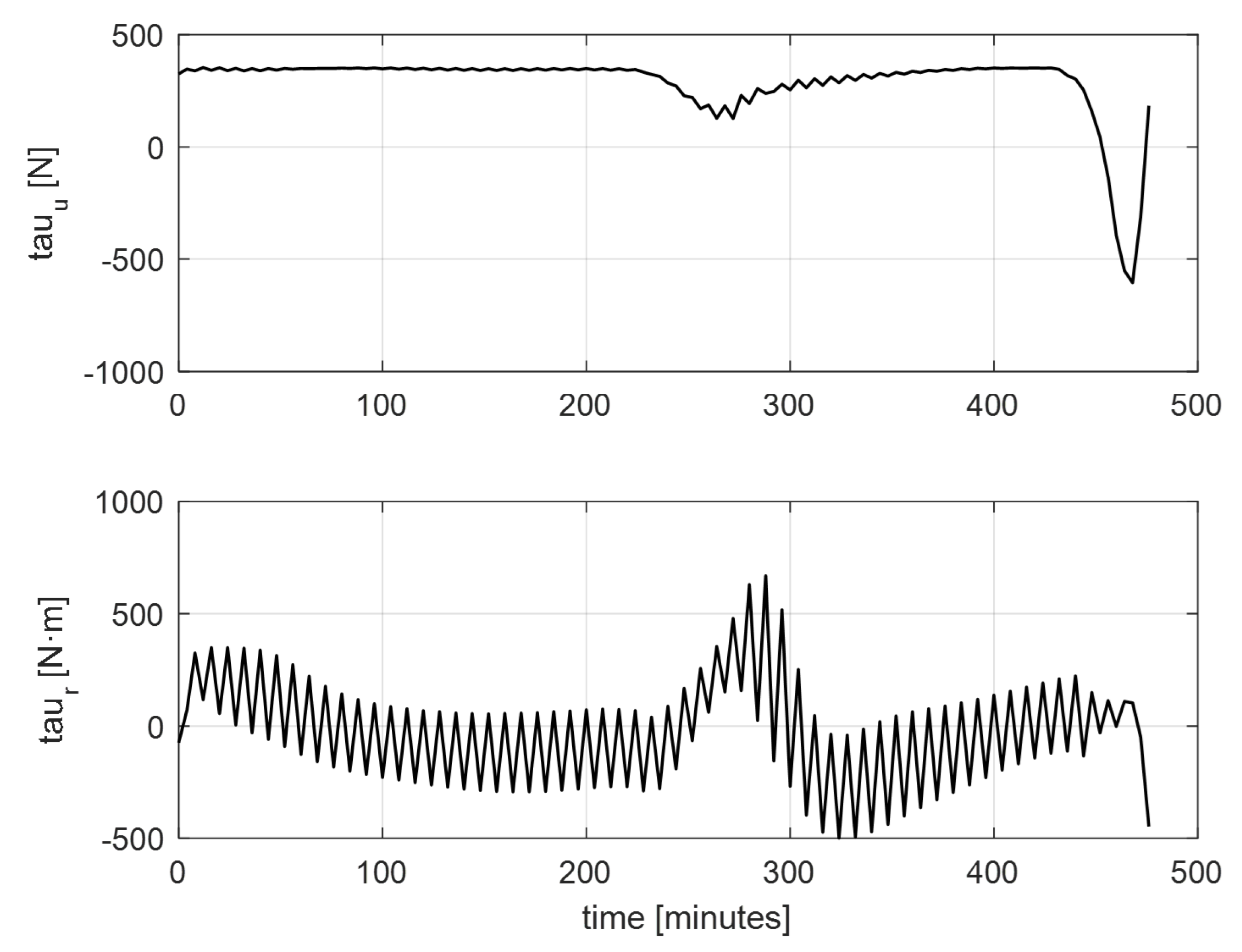
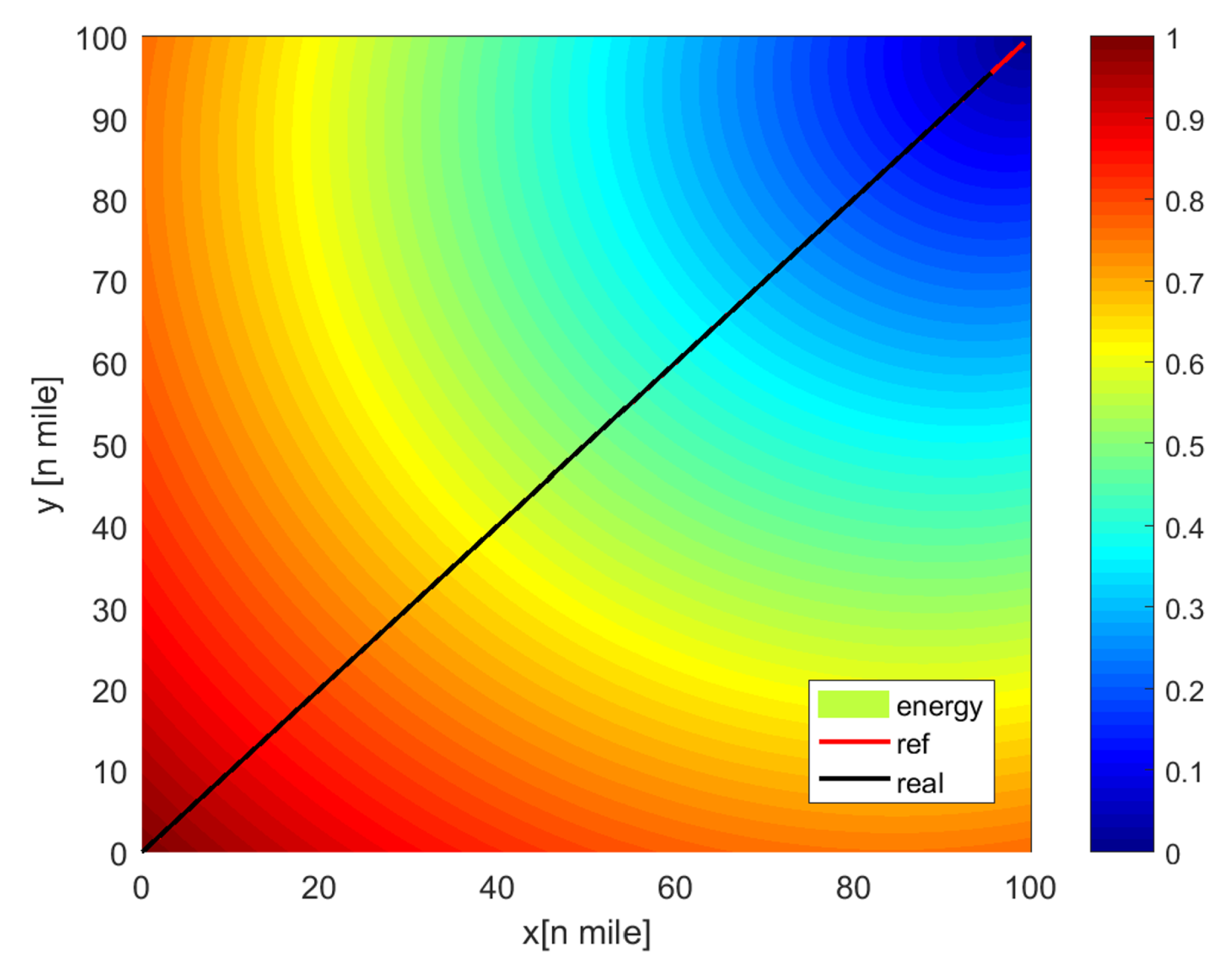
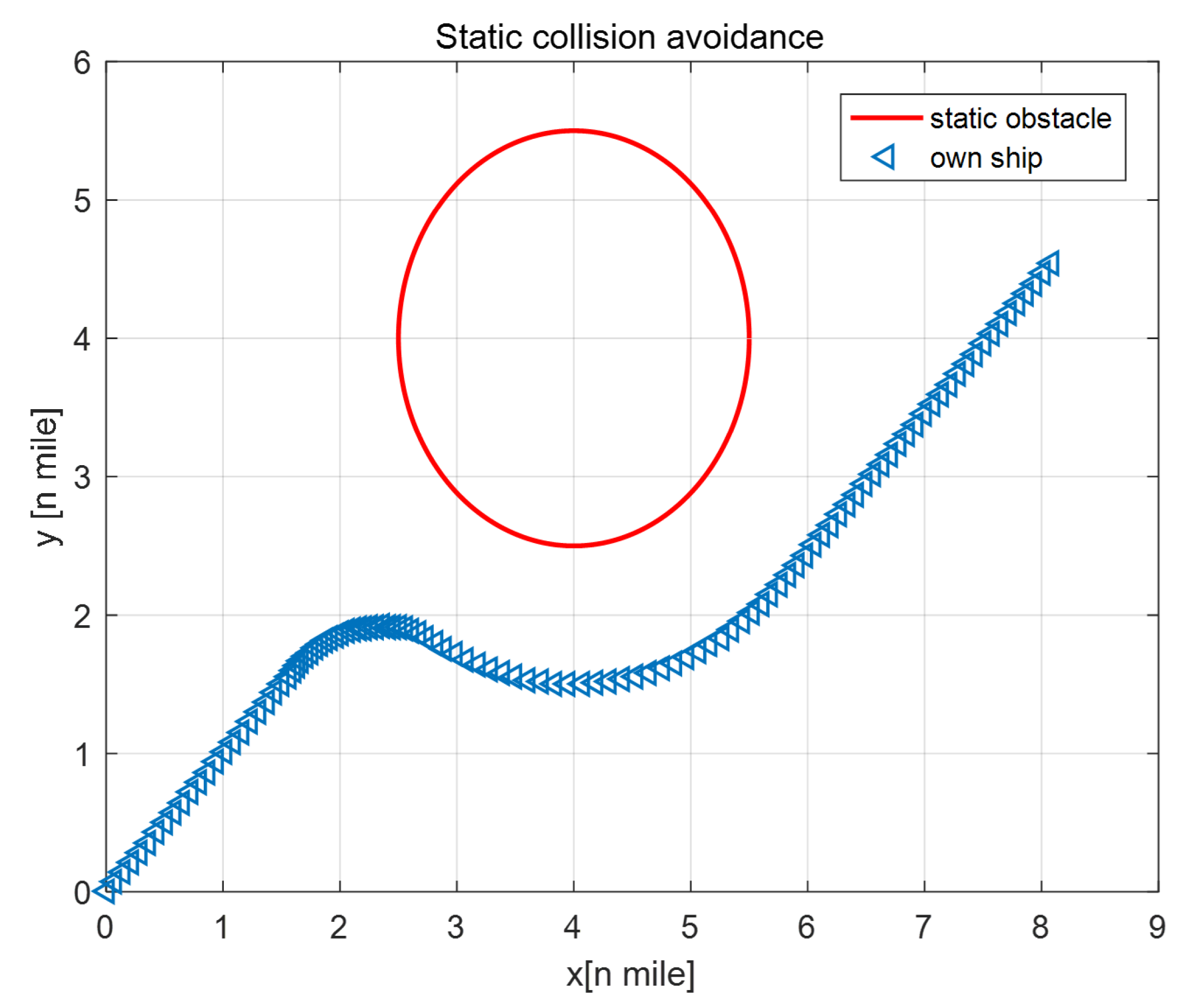
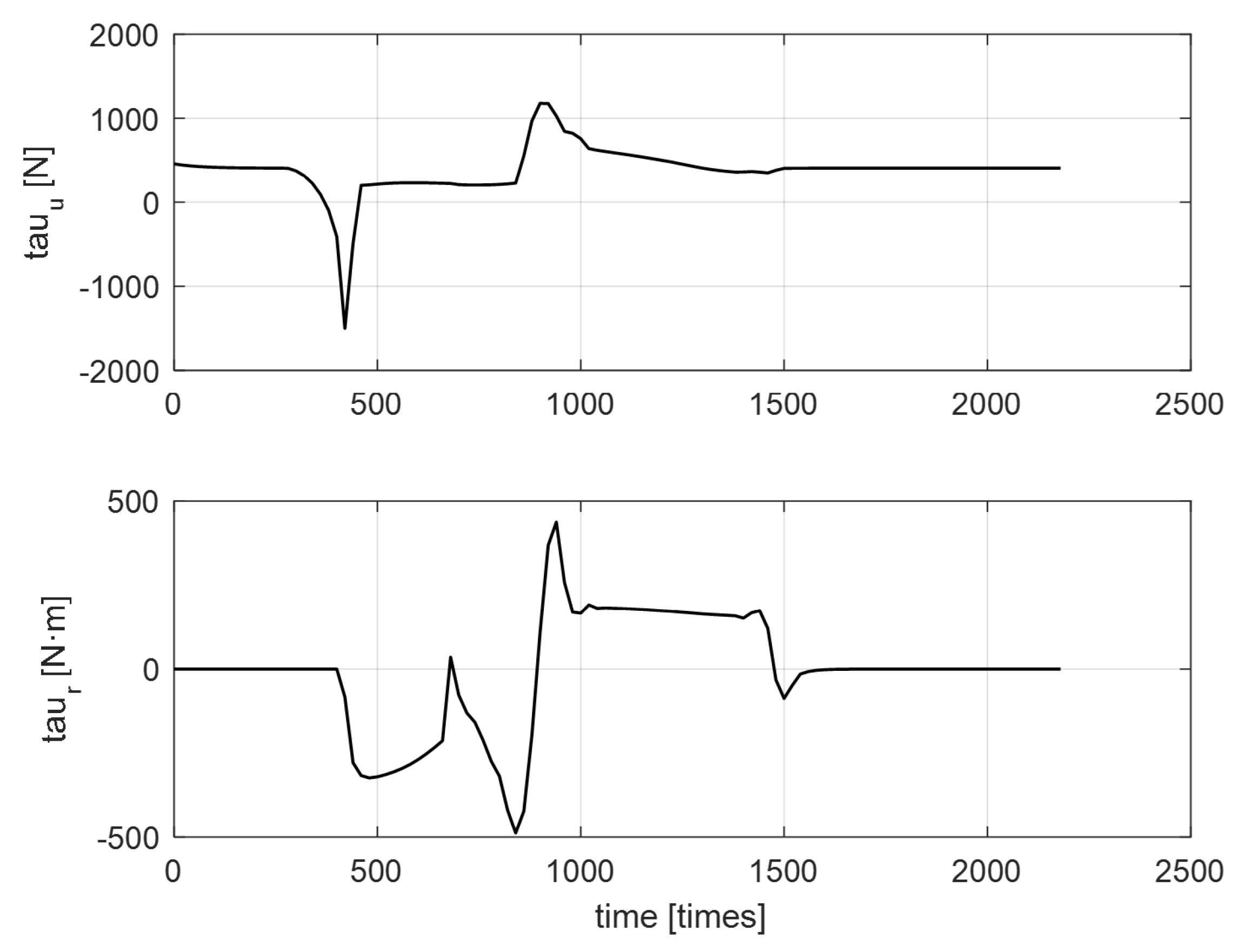
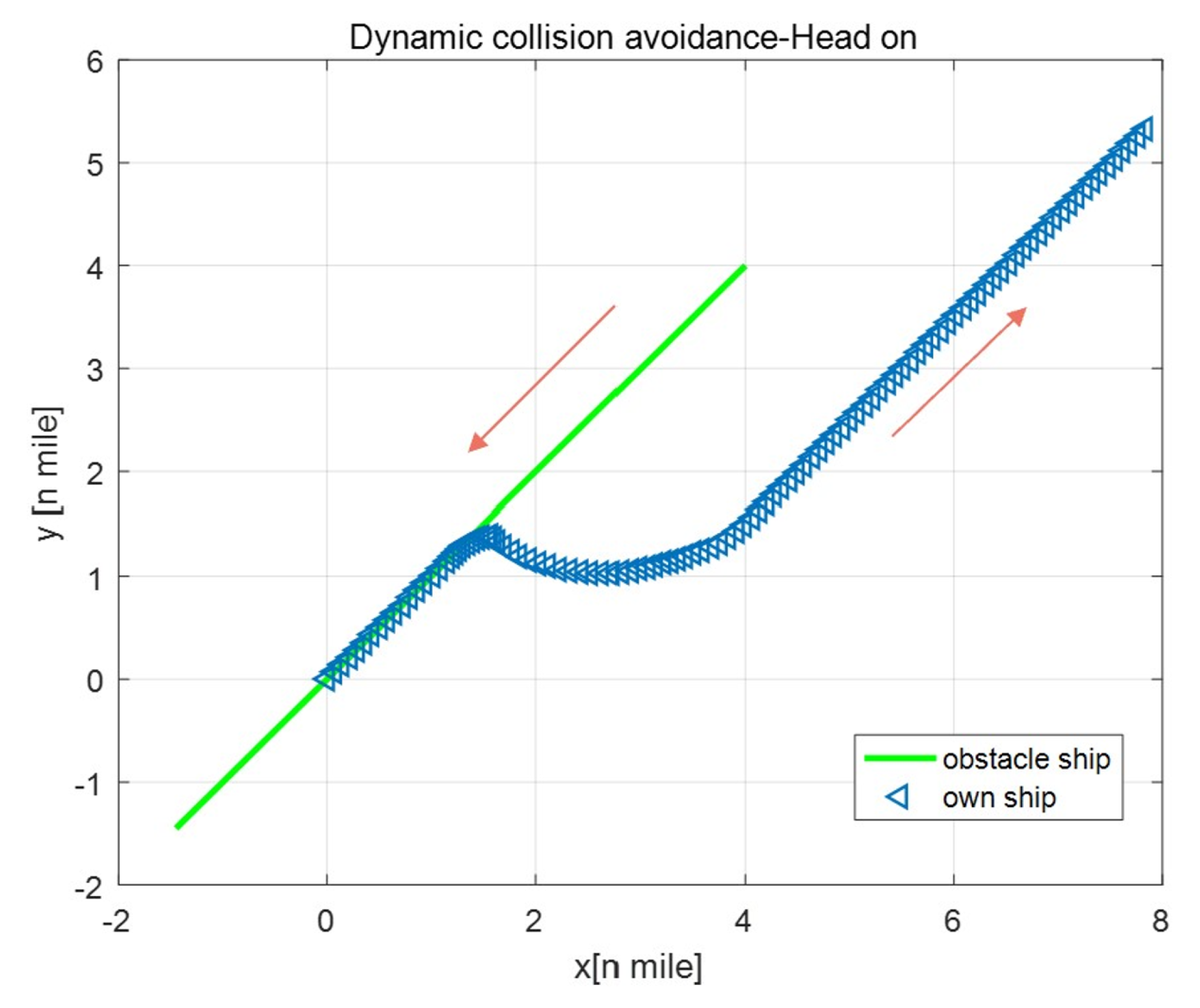
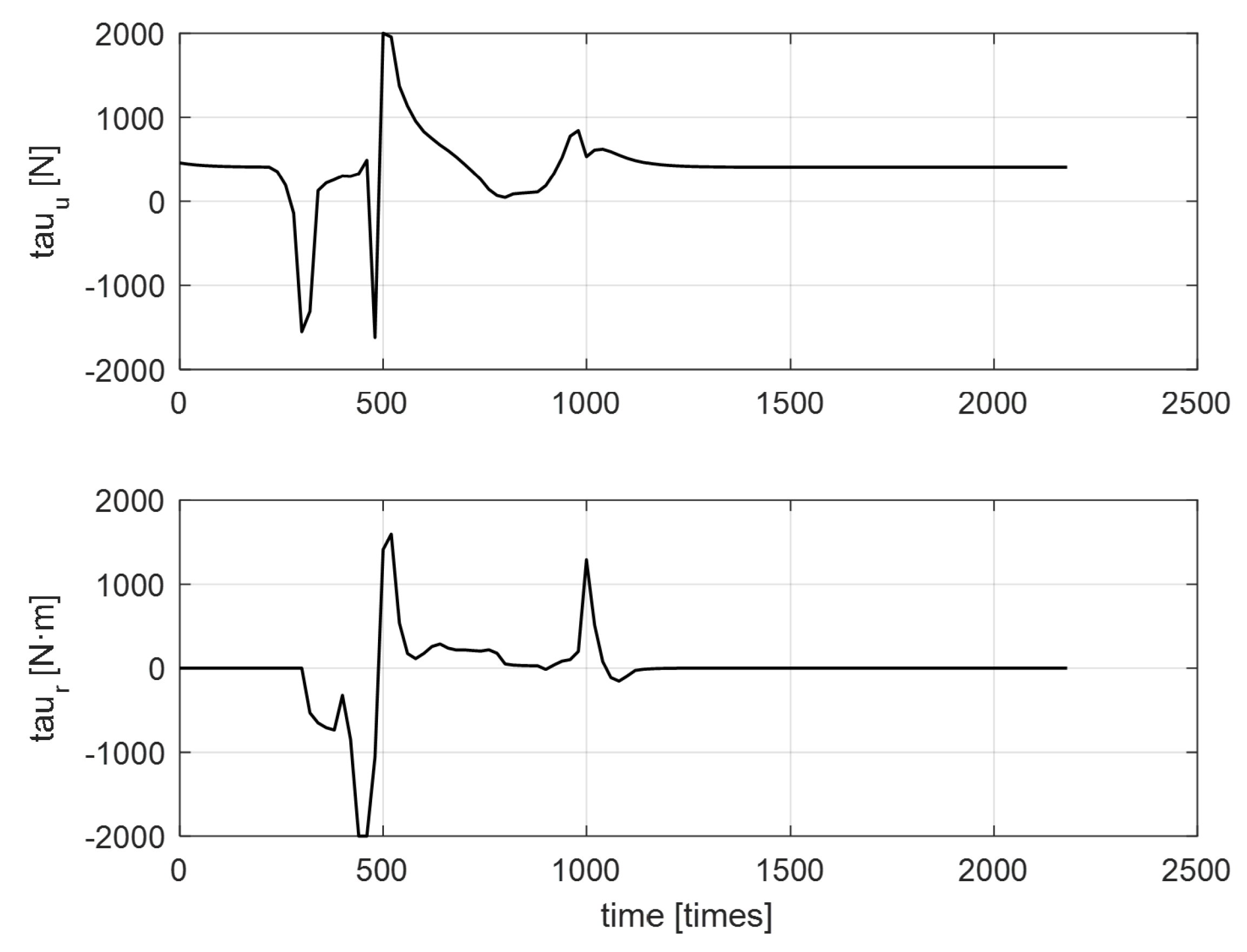
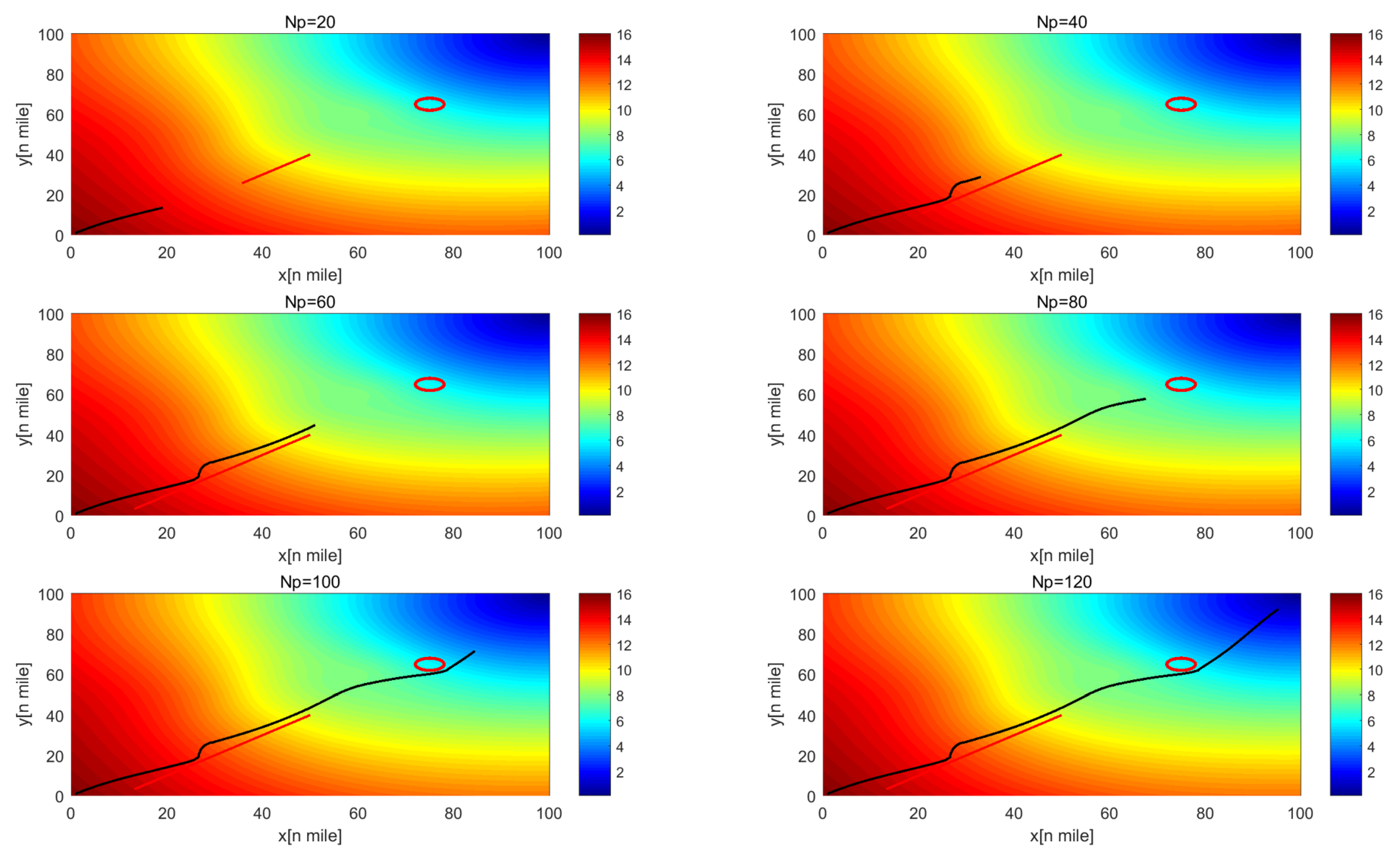

| Parameters | Meanings |
|---|---|
| K | Propeller efficiency |
| Propulsion efficiency (0.6 to 0.7) | |
| Significant wave height | |
| Still water power | |
| Water density | |
| Still water drag coefficient | |
| S | Wetted surface |
| Additional power for wave resistance | |
| Drag coefficient for wave resistance | |
| g | Vertical force |
| B | Ship width |
| L | Ship length |
| Additional power for wave resistance | |
| Drag coefficient for aerodynamic | |
| A | Surface area projected for wind |
| u | Wave speed |
| Wind speed | |
| m | Cargo on board the vessel |
| n | Cargo weight constant |
| r | Wave constant (0.1) |
| Parameters | Value | Unit |
|---|---|---|
| 897.77 | kg | |
| 1718 | kg | |
| 105.34 | kg | |
| 42.77 | kg/s | |
| 863 | kg/s | |
| 51.88 | kg/s | |
| S (wetted surface) | 9424 | m |
| A (wind area) | 2200.43 | m |
| L | 230 | m |
| B | 32.2 | m |
| 1 | ||
| 1 | ||
| 16 | ||
| 0.57e | ||
| 1.27e | m/s | |
| 0.1 |
| Navigation and Control System | EC (USD) | EM (t) | EM per n mile (USD) | EM per n mile (kg) | Time (min) |
|---|---|---|---|---|---|
| RHNC | 1.047 | 31.2642 | 80.74 | 241.10 | 480 |
| Offline-SPNC | 1.1656 | 37.8385 | 88.81 | 288.31 | 460 |
Disclaimer/Publisher’s Note: The statements, opinions and data contained in all publications are solely those of the individual author(s) and contributor(s) and not of MDPI and/or the editor(s). MDPI and/or the editor(s) disclaim responsibility for any injury to people or property resulting from any ideas, methods, instructions or products referred to in the content. |
© 2023 by the authors. Licensee MDPI, Basel, Switzerland. This article is an open access article distributed under the terms and conditions of the Creative Commons Attribution (CC BY) license (https://creativecommons.org/licenses/by/4.0/).
Share and Cite
Zheng, J.; Sun, W.; Li, Y.; Hu, J. A Receding Horizon Navigation and Control System for Autonomous Merchant Ships: Reducing Fuel Costs and Carbon Emissions under the Premise of Safety. J. Mar. Sci. Eng. 2023, 11, 127. https://doi.org/10.3390/jmse11010127
Zheng J, Sun W, Li Y, Hu J. A Receding Horizon Navigation and Control System for Autonomous Merchant Ships: Reducing Fuel Costs and Carbon Emissions under the Premise of Safety. Journal of Marine Science and Engineering. 2023; 11(1):127. https://doi.org/10.3390/jmse11010127
Chicago/Turabian StyleZheng, Jian, Wenjun Sun, Yun Li, and Jiayin Hu. 2023. "A Receding Horizon Navigation and Control System for Autonomous Merchant Ships: Reducing Fuel Costs and Carbon Emissions under the Premise of Safety" Journal of Marine Science and Engineering 11, no. 1: 127. https://doi.org/10.3390/jmse11010127
APA StyleZheng, J., Sun, W., Li, Y., & Hu, J. (2023). A Receding Horizon Navigation and Control System for Autonomous Merchant Ships: Reducing Fuel Costs and Carbon Emissions under the Premise of Safety. Journal of Marine Science and Engineering, 11(1), 127. https://doi.org/10.3390/jmse11010127






